‘Indianapolis’ Category
» posted on Friday, May 10th, 2013 by Linda Lou Burton
Love What You’ve Got
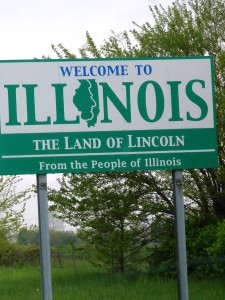 Linda Burton posting from Springfield, Illinois – I woke in Indianapolis today; from my room overlooking the city I watched the sun rise in the morning window-sparkle of downtown skyscrapers. I sleep tonight in Springfield; outside my room a single tree somewhat blocks my view of the long-haul trucks in the parking lot, waiting for daylight to hit the road. Though both cities are the center of government for their state, they are very different in style. Indianapolis (pop 829,718) thrives on the adrenalin of sports; speedways and stadiums dot the landscape, surrounded by the accoutrements that accommodate large crowds; restaurants of every ilk, high-rise hotels, taxi cabs. Stand and cheer! Springfield (pop 116,250) is Lincoln’s land; everywhere is evidence of the quiet reflective man who lived here, is buried here. In Springfield he practiced law; in Springfield he campaigned to become president of the land, though when he arrived he didn’t have money to even buy a bed. Inspiration of a different sort; such is the way of the Journey Across America, now 60% complete (stand and cheer!). Today I claim 30 capital cities as my home towns; for the last 443 days I’ve experienced life with big-city bustle, and small-town charm. I’ve seen mountains and
Linda Burton posting from Springfield, Illinois – I woke in Indianapolis today; from my room overlooking the city I watched the sun rise in the morning window-sparkle of downtown skyscrapers. I sleep tonight in Springfield; outside my room a single tree somewhat blocks my view of the long-haul trucks in the parking lot, waiting for daylight to hit the road. Though both cities are the center of government for their state, they are very different in style. Indianapolis (pop 829,718) thrives on the adrenalin of sports; speedways and stadiums dot the landscape, surrounded by the accoutrements that accommodate large crowds; restaurants of every ilk, high-rise hotels, taxi cabs. Stand and cheer! Springfield (pop 116,250) is Lincoln’s land; everywhere is evidence of the quiet reflective man who lived here, is buried here. In Springfield he practiced law; in Springfield he campaigned to become president of the land, though when he arrived he didn’t have money to even buy a bed. Inspiration of a different sort; such is the way of the Journey Across America, now 60% complete (stand and cheer!). Today I claim 30 capital cities as my home towns; for the last 443 days I’ve experienced life with big-city bustle, and small-town charm. I’ve seen mountains and 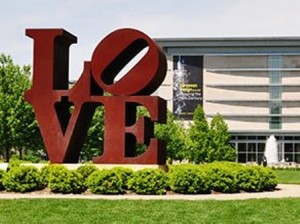 valleys and rivers and lakes, fishing and farming and mining and making things, fresh air and fresh food and history and her story, progress and dropping back and growth and decline, sun belts and bible belts and rust belts and no belts at all, just space. Or congestion. I knew capital cities would be interesting; I had no idea how such a mix of lifestyles and scenery and climate would affect my sensibilities, and begin to explain the world. It’s not what you’ve got that matters, I’ve discovered, it’s how much you love what you’ve got. » read more
valleys and rivers and lakes, fishing and farming and mining and making things, fresh air and fresh food and history and her story, progress and dropping back and growth and decline, sun belts and bible belts and rust belts and no belts at all, just space. Or congestion. I knew capital cities would be interesting; I had no idea how such a mix of lifestyles and scenery and climate would affect my sensibilities, and begin to explain the world. It’s not what you’ve got that matters, I’ve discovered, it’s how much you love what you’ve got. » read more
» posted on Tuesday, May 7th, 2013 by Linda Lou Burton
Rock Solid
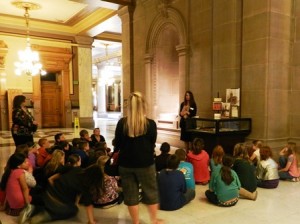 Linda Burton posting from Indianapolis, Indiana – “I know you are very smart,” the tour guide said, her lapel-mike echoing her voice in the great hall, “Your teachers are very good, and you have come here today to learn more about your state. I am proud of you.” “Rapt attention” may sound a bit clichéd, but the fourth-grade class circle-seated on the rotunda’s marble floor was seriously paying attention. I felt pretty smart myself, and right at home; there was something in the air, was it the light filtering through the colorful art-glass dome of the rotunda? Or the pleasant musty smell of the oaks doors facing the spacious hall – offices of the Governor, the Secretary of State, the
Linda Burton posting from Indianapolis, Indiana – “I know you are very smart,” the tour guide said, her lapel-mike echoing her voice in the great hall, “Your teachers are very good, and you have come here today to learn more about your state. I am proud of you.” “Rapt attention” may sound a bit clichéd, but the fourth-grade class circle-seated on the rotunda’s marble floor was seriously paying attention. I felt pretty smart myself, and right at home; there was something in the air, was it the light filtering through the colorful art-glass dome of the rotunda? Or the pleasant musty smell of the oaks doors facing the spacious hall – offices of the Governor, the Secretary of State, the 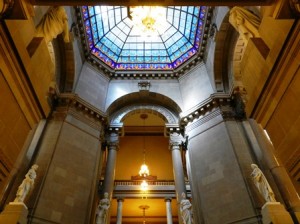 Treasurer – knock to come in, communicate. Upstairs, on the balcony, I passed a window-in-the-wall that allowed a view straight into the Senate chambers; a passing staff member explained – “We want people to know what’s going on. You can watch from the hallway or the gallery above.” No session today, but the Chamber doors were open; “You’re welcome to go in,” she urged, “And don’t miss the Supreme Court room.” I followed her suggestion, noting the “Activities For Kids” bulletin board just outside the Supreme Court door. Inside I settled in a wooden chair to rest a moment and opened the booklet I’d picked up at the Visitors Desk. I read the chapter titles first: A Center of Civic Life. In Character With The Parthenon. In Clear Arrangement. The First One Hundred Years. Restoration At Its Best. A Solid Foundation. I flipped to the last sentence on the last page: “Indiana’s State House has a rock-solid foundation.” My interest was thoroughly piqued by now, I decided to begin at the beginning. » read more
Treasurer – knock to come in, communicate. Upstairs, on the balcony, I passed a window-in-the-wall that allowed a view straight into the Senate chambers; a passing staff member explained – “We want people to know what’s going on. You can watch from the hallway or the gallery above.” No session today, but the Chamber doors were open; “You’re welcome to go in,” she urged, “And don’t miss the Supreme Court room.” I followed her suggestion, noting the “Activities For Kids” bulletin board just outside the Supreme Court door. Inside I settled in a wooden chair to rest a moment and opened the booklet I’d picked up at the Visitors Desk. I read the chapter titles first: A Center of Civic Life. In Character With The Parthenon. In Clear Arrangement. The First One Hundred Years. Restoration At Its Best. A Solid Foundation. I flipped to the last sentence on the last page: “Indiana’s State House has a rock-solid foundation.” My interest was thoroughly piqued by now, I decided to begin at the beginning. » read more
» posted on Friday, May 3rd, 2013 by Linda Lou Burton
Two Hoosier Guys
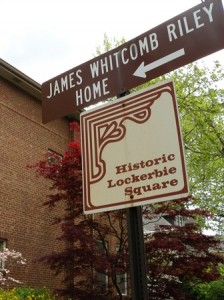 Linda Burton posting from Indianapolis, Indiana – An unopened letter under glass. A hat and cane on the bed. These lonely mementos are remnants of the lives of two men whose words have touched virtually every school child and avid reader of the last hundred years. I’m talking about James Whitcomb Riley (1849-1916) and Kurt Vonnegut Jr (1922-2007), both with inextricable ties to Indianapolis. Riley was an American writer known as the Hoosier Poet. His work tended to be humorous or sentimental and most of the thousand poems he published were in dialect, like Little Orphant Annie (1885). Vonnegut was an American writer known for his unique blend of satire and science fiction. His black comic voice became his trademark in novels such as Slaughterhouse Five (1969). The James Whitcomb Riley Museum Home and the Kurt Vonnegut Memorial Library sit only blocks apart in downtown Indianapolis. I visited both today, looking for more personal glimpses of the men and hoping to better understand what led them down their
Linda Burton posting from Indianapolis, Indiana – An unopened letter under glass. A hat and cane on the bed. These lonely mementos are remnants of the lives of two men whose words have touched virtually every school child and avid reader of the last hundred years. I’m talking about James Whitcomb Riley (1849-1916) and Kurt Vonnegut Jr (1922-2007), both with inextricable ties to Indianapolis. Riley was an American writer known as the Hoosier Poet. His work tended to be humorous or sentimental and most of the thousand poems he published were in dialect, like Little Orphant Annie (1885). Vonnegut was an American writer known for his unique blend of satire and science fiction. His black comic voice became his trademark in novels such as Slaughterhouse Five (1969). The James Whitcomb Riley Museum Home and the Kurt Vonnegut Memorial Library sit only blocks apart in downtown Indianapolis. I visited both today, looking for more personal glimpses of the men and hoping to better understand what led them down their 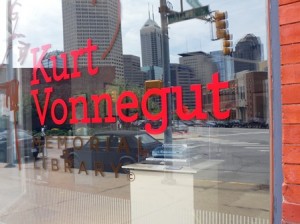 chosen paths. I never thought of them as anything alike, but before the day was over, I found that I was wrong; they had a great deal in common. Though born in different centuries, they grew up on Indiana time; little boys raised with Indiana values. As with most of us, they were greatly influenced by their families. James was the third of the six children of Reuben and Elizabeth Riley; Kurt Jr was the youngest of three children born to Kurt and Edith Vonnegut. Both families suffered a traumatic change of circumstances that reflected forever in the writings, and behaviors, of these two men. » read more
chosen paths. I never thought of them as anything alike, but before the day was over, I found that I was wrong; they had a great deal in common. Though born in different centuries, they grew up on Indiana time; little boys raised with Indiana values. As with most of us, they were greatly influenced by their families. James was the third of the six children of Reuben and Elizabeth Riley; Kurt Jr was the youngest of three children born to Kurt and Edith Vonnegut. Both families suffered a traumatic change of circumstances that reflected forever in the writings, and behaviors, of these two men. » read more
» posted on Wednesday, May 1st, 2013 by Linda Lou Burton
Birth Of A Capital City
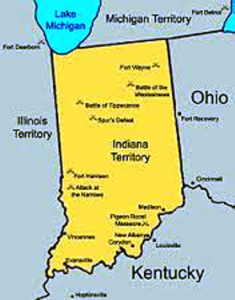 Linda Burton posting from Indianapolis, Indiana –How many capital cities have the name of the state within the name of the city? The answer is at the end of this post, but obviously Indianapolis is one. The name was created by joining “Indiana” with “polis,” which is the Greek word for “city.” Yes, Indianapolis literally means Indiana City (like Oklahoma City, a trivia hint for you). So the next question is “what does Indiana mean?” I won’t go into all of the Indian wars and treaties that occurred as the United States expanded westward; I’ll start with July 4, 1800, when Indiana Territory was pulled out of the larger Northwest Territory. Vincennes, a former French trading post and one of the only white settlements in the vast territory, was named capital. At that time about five thousand white Europeans lived north of the Ohio River; Native Americans
Linda Burton posting from Indianapolis, Indiana –How many capital cities have the name of the state within the name of the city? The answer is at the end of this post, but obviously Indianapolis is one. The name was created by joining “Indiana” with “polis,” which is the Greek word for “city.” Yes, Indianapolis literally means Indiana City (like Oklahoma City, a trivia hint for you). So the next question is “what does Indiana mean?” I won’t go into all of the Indian wars and treaties that occurred as the United States expanded westward; I’ll start with July 4, 1800, when Indiana Territory was pulled out of the larger Northwest Territory. Vincennes, a former French trading post and one of the only white settlements in the vast territory, was named capital. At that time about five thousand white Europeans lived north of the Ohio River; Native Americans  occupied most of the Territory, referred to as “Land of the Indians,” aka Indiana. Fast forward to December 1813: Corydon was named the second capital of Indiana Territory, and the wheels began to turn for statehood. President James Madison approved Indiana’s admission into the Union December 11, 1816 as the 19th state. The capital could not be located in the central part of the state at that time because the land was controlled by Native Americans; however in an 1818 treaty the area was opened for white settlement; an unprecedented migration followed. A central location for a capital city became imperative then; on January 11, 1820 Governor Jennings commissioned 10 men to select a site for the permanent capital. They chose a spot at the junction of Fall Creek and White River; the legislature ratified their selection January 6, 1821, and the building of a capital city began. Enter Alexander Ralston. » read more
occupied most of the Territory, referred to as “Land of the Indians,” aka Indiana. Fast forward to December 1813: Corydon was named the second capital of Indiana Territory, and the wheels began to turn for statehood. President James Madison approved Indiana’s admission into the Union December 11, 1816 as the 19th state. The capital could not be located in the central part of the state at that time because the land was controlled by Native Americans; however in an 1818 treaty the area was opened for white settlement; an unprecedented migration followed. A central location for a capital city became imperative then; on January 11, 1820 Governor Jennings commissioned 10 men to select a site for the permanent capital. They chose a spot at the junction of Fall Creek and White River; the legislature ratified their selection January 6, 1821, and the building of a capital city began. Enter Alexander Ralston. » read more
» posted on Monday, April 29th, 2013 by Linda Lou Burton
Not To Brag
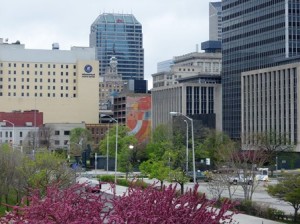 Linda Burton posting from Indianapolis, Indiana – Cherry trees? I’m not sure about the small grove of brilliant pink just below my hotel window in a tiny pocket park, but they are full-bloomed out and looking fine today. Across the street the trees need a few more days of sun, although the grass below is high; a city groundskeeper is circling each tree with his mowing machine. I’m looking straight into downtown Indianapolis, the second-largest of the 50 capital cities with a population of 829,718 (US Census 2010). And I’m reading the Indy Visitor Guide, trying to get my bearings and make a plan. I’m just five blocks from the State Capitol, straight down Washington Street; and I can see the top of the monument in Monument Circle tucked between tall buildings, just two blocks away. Very cool. The cover of the Spring/Summer
Linda Burton posting from Indianapolis, Indiana – Cherry trees? I’m not sure about the small grove of brilliant pink just below my hotel window in a tiny pocket park, but they are full-bloomed out and looking fine today. Across the street the trees need a few more days of sun, although the grass below is high; a city groundskeeper is circling each tree with his mowing machine. I’m looking straight into downtown Indianapolis, the second-largest of the 50 capital cities with a population of 829,718 (US Census 2010). And I’m reading the Indy Visitor Guide, trying to get my bearings and make a plan. I’m just five blocks from the State Capitol, straight down Washington Street; and I can see the top of the monument in Monument Circle tucked between tall buildings, just two blocks away. Very cool. The cover of the Spring/Summer 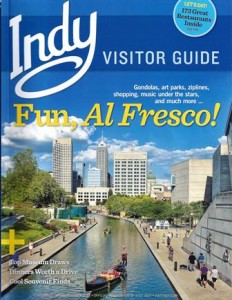 2013 version of Visit Indy surprises me – a gondolier in a black and white striped shirt guiding a gondola on a canal? Am I in Venice, or the middle of the USA? But that’s what it promises: gondolas, art parks, ziplines, shopping, music, and more. Let’s Eat! it implores. 173 Great Restaurants! The Indy 500 is all I really know about Indianapolis; Visit Indy tells me that 400,000 people attend the various races at the Speedway every year. But get this – 22 million people visit the city every year (that averages out to 60,000 people a day). And no wonder so many people come to Indianapolis – 50% of the population of the United States lives within an 8-hour drive! This is serious tourism bragging going on, well, I guess I’d brag too over such impressive numbers. I keep reading. » read more
2013 version of Visit Indy surprises me – a gondolier in a black and white striped shirt guiding a gondola on a canal? Am I in Venice, or the middle of the USA? But that’s what it promises: gondolas, art parks, ziplines, shopping, music, and more. Let’s Eat! it implores. 173 Great Restaurants! The Indy 500 is all I really know about Indianapolis; Visit Indy tells me that 400,000 people attend the various races at the Speedway every year. But get this – 22 million people visit the city every year (that averages out to 60,000 people a day). And no wonder so many people come to Indianapolis – 50% of the population of the United States lives within an 8-hour drive! This is serious tourism bragging going on, well, I guess I’d brag too over such impressive numbers. I keep reading. » read more
